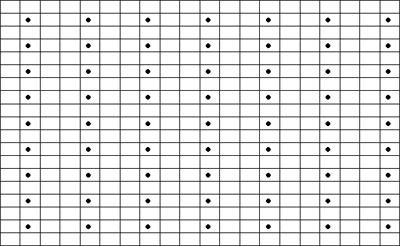Another common form of sampling in forest timber and range
inventories is systematic sampling. Using this approach an initial
experimental unit is established, usually randomly, and then
sampling units are chosen at a uniform spacing.
Systematic sampling has a few advantages over simple random
sampling:
- First, the experimental units are easy to locate since they
are evenly spaced.
- Second, they appear to be more representative
since they are evenly spaced across the population.
However, the disadvantages are that it is hard to estimate
variance or standard error for one systematic sample and that it is
possible the accuracy could be very low if the sampling coincides
with a periodic variation inherent in the landscape.
Although this sampling design has been widely used it is best
suited for times when only an estimation of the mean is needed. If
an estimation of precision needs to calculated it would be best to
use a random sampling design

Figure 2. A possible arrangement 63 samples using a systemic
sampling design. |
